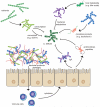Interaction between the intestinal microbiota and host in Clostridium difficile colonization resistance
- PMID: 22595318
- PMCID: PMC3408078
- DOI: 10.1016/j.tim.2012.04.001
Interaction between the intestinal microbiota and host in Clostridium difficile colonization resistance
Abstract
Clostridium difficile infection (CDI) has become one of the most prevalent and costly nosocomial infections. In spite of the importance of CDI, our knowledge of the pathogenesis of this infection is still rudimentary. Although previous use of antibiotics is generally considered to be the sine qua non of CDI, the mechanisms by which antibiotics render the host susceptible to C. difficile are not well defined. In this review, we will explore what is known about how the indigenous microbiota acts in concert with the host to prevent colonization and virulence of C. difficile and how antibiotic administration disturbs host-microbiota homeostasis, leading to CDI.
Copyright © 2012 Elsevier Ltd. All rights reserved.
Figures


References
-
- Dubberke ER, Wertheimer AI. Review of current literature on the economic burden of Clostridium difficile infection. Infect Control Hosp Epidemiol. 2009;30:57–66. - PubMed
-
- Proctor LM. The Human Microbiome Project in 2011 and beyond. Cell Host Microbe. 2011;10:287–291. - PubMed
-
- Kelly CP, Kyne L. The host immune response to Clostridium difficile. J Med Microbiol. 2011;60:1070–1079. - PubMed
-
- Tedesco FJ, et al. Clindamycin-associated colitis. A prospective study. Ann Intern Med. 1974;81:429–433. - PubMed
-
- Bartlett JG, et al. Clindamycin-associated colitis due to a toxin-producing species of Clostridium in hamsters. J Infect Dis. 1977;136:701–705. - PubMed
Publication types
MeSH terms
Substances
Grants and funding
LinkOut - more resources
Full Text Sources
Other Literature Sources
Medical
Molecular Biology Databases

